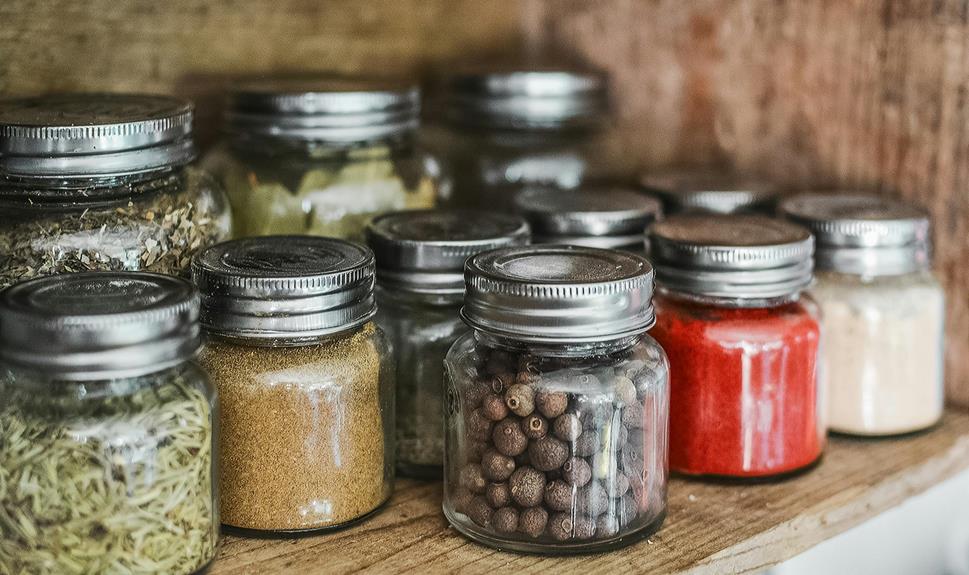Pruning your thyme in an Aerogarden isn't just about maintaining an aesthetically pleasing miniature herb garden; it's an essential step to guarantee robust growth and abundant harvests. You'll want to start by identifying the new growth—this is where you'll make your cuts. Trim the thyme back to about 3-4 inches to promote a bushier plant, which, in turn, can lead to more leaves for your culinary experiments. Always use sterilized scissors or shears to prevent any disease from spreading. Now, while it might seem straightforward, the timing and technique of these cuts can greatly influence the health of your thyme. Wondering how exactly these factors play into the vitality of your herbs? Let's explore the impact of precision in pruning.
Key Takeaways
- Wait for thyme to reach 3-4 inches before pruning to stimulate bushier growth.
- Use sharp scissors or pruning shears sterilized with cleaning alcohol.
- Trim the top third of the plant, focusing on just above a leaf node.
- After pruning, adjust the Aerogarden's lights to ensure even exposure.
- Monitor and adjust water and nutrients in the Aerogarden to support recovery.
Understanding Thyme Growth
Thyme typically grows quickly, so you'll need to monitor its progress regularly to keep it healthy in your Aerogarden. This herb thrives under specific conditions that you can manage and optimize for maximum growth. You're in control of factors like water levels, nutrient feed, and light exposure, all essential for your thyme's development.
Understanding the growth patterns of thyme will help you anticipate its needs. Thyme loves a good balance of light and moisture, but each variety may react differently to these conditions. You should check how your specific type of thyme responds to the environment you've set in your Aerogarden. This knowledge enables you to adjust settings more precisely, ensuring your thyme doesn't just grow, but flourishes.
Keep an eye on the root system as well. Thyme's roots can become too dense, potentially hindering its growth. By regularly checking and gently adjusting the roots, you prevent them from overcrowding, which can stress the plant. This proactive approach not only maintains the health of your thyme but also enhances its flavor and longevity in your Aerogarden.
You're steering the ship here; with diligent monitoring and adjustments, your thyme will prosper under your watchful eye.
Benefits of Regular Pruning
Regular pruning not only enhances your thyme's health but also stimulates robust growth in your Aerogarden. By routinely cutting back the older stems, you encourage your plants to develop a bushier, more productive form. This practice keeps your thyme looking its best and performing at its peak, ensuring you can enjoy a continuous supply of fresh herbs.
Here are three key benefits of keeping up with your thyme's pruning needs:
- Increased Yield: Regularly pruned thyme plants redirect their energy from growing lengthy, unproductive stems to developing new, flavorful leaves. This means you'll harvest a greater volume of herbs from each plant.
- Disease Prevention: Overgrown thyme can become a breeding ground for diseases due to poor air circulation. By pruning, you open up the plant, allowing air and light to better penetrate, reducing the risk of fungal infections and other diseases.
- Extended Plant Lifespan: Consistent pruning helps prevent your thyme from overexerting itself on old growth, which can lead to a decline in health and vigor. Regular trimming keeps the plant youthful and vigorous, extending its productive lifespan in your Aerogarden.
Identifying the Right Time to Prune
Knowing when to prune your thyme in the Aerogarden is as important as the pruning process itself. You'll want to master this timing to guarantee your plant remains vigorous and productive.
The best time for pruning is when your thyme is showing signs of new growth. This typically occurs a few weeks after planting. You're aiming for a period when the plant is young but established enough to handle trimming without stress. Look for the plant to be about three to four inches tall—that's your green light.
Don't wait until it's overgrown; larger, woodier stems can become tough and decrease the plant's overall health. Additionally, monitoring the growth cycle allows you to prune at strategic times that encourage flourishing.
Pruning right before a growth spurt can promote bushier growth, leading to a heartier harvest. This proactive approach puts you in control, optimizing plant health and yield.
Tools Needed for Pruning
You'll need a few essential tools to effectively prune your thyme in the Aerogarden. Ensuring you have the right equipment won't only make the task simpler but also help maintain the health and productivity of your herbs. Here's what you should have on hand:
- Sharp Scissors or Pruning Shears: You'll want a pair of sharp scissors or specialized pruning shears. Dull tools can damage the plants by crushing the stems instead of making clean cuts. This precision is vital for promoting healthy regrowth.
- Tweezers: Sometimes, thyme plants can become quite dense, making it difficult to reach the smaller stems with scissors alone. A pair of tweezers can be invaluable for gently removing leaves or debris that are cluttering the base of the plant without disturbing the roots.
- Cleaning Alcohol: Before and after you prune, it's wise to sterilize your tools using cleaning alcohol. This step prevents the spread of any potential diseases between plants. Just dip the blades of your scissors or shears in the alcohol, and you're ready to go.
Preparing Your Aerogarden
Before pruning your thyme, make sure your Aerogarden is properly prepared to support healthy growth and easy access. Start by evaluating the water level in your Aerogarden's reservoir. It's essential you keep it topped up to guarantee your thyme isn't stressed by a lack of nutrients, which can be harmful to its health and growth.
Next, check the pH level of the water. Thyme thrives best in a slightly acidic environment, so aim for a pH between 5.5 and 6.5. You'll find pH testing kits online or at your local garden center. Adjusting the pH precisely gives you control over the nutrient uptake, optimizing your thyme's health before you even begin pruning.
Ensure the grow lights are properly adjusted. Thyme requires plenty of light, especially if you want robust growth and essential oil production. Position the lights so they're close enough to nourish the plants without scorching them. This setup not only promotes growth but also makes your pruning task easier by strengthening the plant's structure.
Step-by-Step Pruning Process
Start by selecting the oldest and most overgrown stems to prune first, making sure your thyme remains healthy and vibrant. Use sharp, clean scissors or pruning shears for a precise cut.
Here's how you'll master the pruning process:
- Identify the Target Areas: Focus on stems that are woody and have fewer leaves. These are typically your oldest growths. Cutting these back will stimulate new, lush growth and help maintain an ideal shape.
- Make Strategic Cuts: Cut each selected stem about a third of the way down, just above a leaf node. This is where new growth will sprout. Be certain you're making your cuts at a 45-degree angle to promote healing and prevent water accumulation, which could lead to disease.
- Thin Out Dense Areas: If your thyme is looking particularly bushy, thin out some of the interior stems. This improves air circulation around the plant, which is essential for preventing mold and promoting overall plant health.
Managing Overgrown Thyme Plants
Managing overgrown thyme plants in your Aerogarden often requires more than regular pruning to maintain peak health and productivity. When you notice your thyme getting out of control, it's important to take immediate action to prevent it from overshadowing other plants and compromising the system's efficiency.
Firstly, assess the situation. Identify which sections are excessively dense and are likely blocking light or air circulation to smaller, less vigorous plants. You'll want to tackle these areas first. Start by removing any dead or dying stems; these not only look unappealing but can also harbor pests and diseases.
Next, focus on the thickest parts of the plant. Cut back these sections more drastically than others to encourage a more balanced growth. Remember, thyme is a resilient herb and responds well to being cut back, so don't be too conservative. This will also enhance the light and air flow to all parts of your Aerogarden, promoting a healthier environment.
Aftercare and Maintenance
After pruning your thyme, you'll often need to adjust the nutrient levels in your Aerogarden to support the plant's recovery and continued growth. Maintaining a healthy growth environment is vital to make sure your thyme thrives post-pruning. You're in control, and tweaking the balance of water and nutrients directly impacts your thyme's health.
Here are three key steps to effectively maintain your thyme in the Aerogarden:
- Monitor Water Levels:
Keep a close eye on the water level daily. Thyme doesn't like too much water, so make sure the water level doesn't exceed the fill line. This prevents root rot and promotes healthier growth.
- Adjust Nutrient Concentration:
Post-pruning, your thyme needs a balanced diet to flourish. Add nutrients right after pruning and adjust as needed based on plant response. If the leaves look pale, it might indicate a need for more nutrients.
- Ensure Adequate Light:
Thyme requires plenty of light, especially after being pruned back. Check that your Aerogarden lights are working correctly and positioned to cover all plants evenly. Adjust the light intensity or duration to optimize growth without causing stress to the plants.
Tips for Harvesting Thyme
Once your thyme is well-maintained and thriving, it's time to think about how best to harvest it for maximum flavor and growth. You'll want to take control of the process to make sure you're not only reaping the best taste but also encouraging your plant to produce more robustly.
Start by selecting just the right time for harvesting—early morning right after the dew has evaporated. This is when your thyme's essential oils are at their peak, promising you the most potent flavors. Using clean, sharp scissors, cut only the top third of each stem. This precise trimming encourages the plant to branch out, leading to fuller growth.
Make sure you're harvesting regularly, at least every few weeks, to prevent your thyme from becoming woody and overgrown. This regular cutting back puts you in control of the plant's shape and health, promoting a continuous supply of fresh herbs.
Avoid the common mistake of waiting too long between harvests. If you see flowers starting to form, it's a signal you've waited a bit too long. While thyme flowers are edible, their appearance often means the plant is focusing more on reproduction than leaf growth. Stay proactive and keep your thyme in prime condition.





Konnichiwa! (Hello!) I'm Pat Tokuyama, a Japanese tofu cookbook author, who travels for music, food, and adventure. If you like Japanese tea, checkout some of the newestorganic japanese tea, matcha bowls and noren and more!
** Curious about the Plant Based Japanese Cooking Club? ** Learn more here!